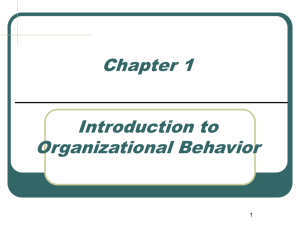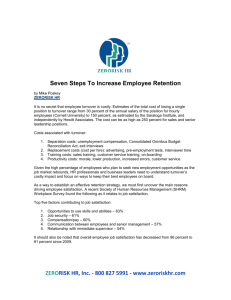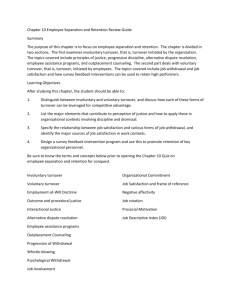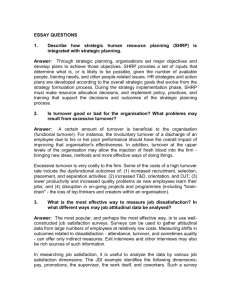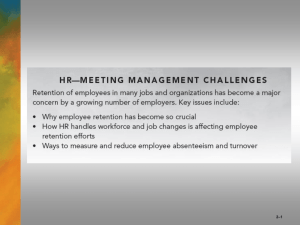Individual/Organization - Craig W. Fontaine, Ph.D.
advertisement
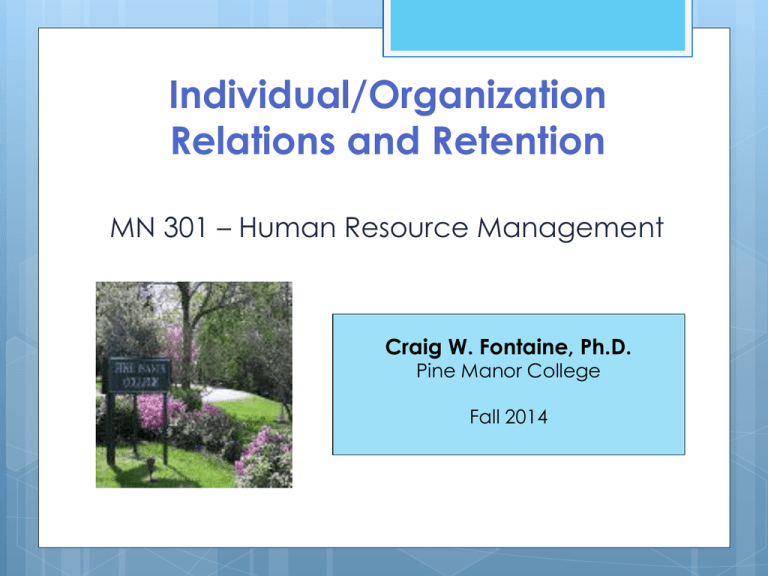
Individual/Organization Relations and Retention MN 301 – Human Resource Management Craig W. Fontaine, Ph.D. Pine Manor College Fall 2014 Individual Performance Factors Individual’s Effort ability to do the work expended Organizational support Performance (P) = Ability (A) x Effort (E) x Support (S) Components of Individual Performance Individual Motivation Motivation: Desire within a person causing that person to act Influences of motivation Performance Reaction to compensation Turnover Other HR concerns Approaches to Understanding Motivation Need theory Maslow classified human needs into five categories Physiological Safety needs and security needs Belonging Esteem and love needs needs Self-actualization needs Until the more basic needs are adequately fulfilled, a person will not fully strive to meet higher needs Approaches to Understanding Motivation Two factor theory Frederick Herzberg’s motivation/hygiene theory assumes that one group of factors, motivators, accounts for motivation But hygiene factors can cause dissatisfaction with work Implication of Herzberg’s research… Need Theory and Two Factor Theory Compared Approaches to Understanding Motivation Equity theory (Social Comparison Theory) People want to be treated fairly at work Equity: Perceived fairness of what the person does compared with what the person receives for it Inputs - What a person brings to the organization Outcomes - Rewards obtained in exchange for inputs Approaches to Understanding Motivation Expectancy theory (Cognitive Theory) Brought about by Lyman Porter and E. E. Lawler Indicates that motivation is also influenced by people’s expectations Individuals base decisions about their behaviors on their expectations… Simplified Expectancy Model of Motivation Motivation by Organizations Financial rewards Performance management Others Praise, trust, and recognition Autonomy to do one’s job Motivation by Organizations Motivation requires diagnosis of organization’s efforts and employee’s: Efforts Abilities Expectations Psychological Contract Unwritten expectations employees and employers have about the nature of their work relationships Useful in understanding individuals’ relationships with their employers Create positive or negative relationship between the employer and individual Based on trust that leads to meeting employer’s and employee’s expectations and needs Expectation of a Psychological Contract Employers will Provide • Competitive compensation and benefits • Flexibility to balance work and home life • Career development opportunities Employees will Contribute • Continuous skill improvement and increased productivity • Reasonable time with the Organization • Extra efforts and results when needed Global Psychological Contract Concerns Psychological Psychological contracts vary differ by country contract expectations of employees from different cultures need to be met by multinational firms Job Satisfaction and Commitment Job satisfaction: Positive emotional state resulting from evaluating one’s job experience Morale - Job satisfaction of a group or organization Attitude survey: Focuses on employees’ feelings and beliefs about their jobs and the organization Components of Job Satisfaction Commitment and Engagement Organization commitment: Degree to which employees believe in and accept organizational goals and desire to remain with the organization Employee engagement: Extent to which an employee feels linked to organizational success Loyalty: Being faithful to an institution or employer Engaged and Disengaged Employees Employee Absenteeism Any failure by an employee to report for work as scheduled or to stay at work when scheduled Effective absence management is a balance between: Supporting employees who are legitimately not at work Keeping operational needs covered Employee Absenteeism Types Involuntary absences Voluntary absences Sources of Direct and Indirect Costs of Absenteeism Methods of Addressing Absenteeism Disciplinary approach People who are absent the first time receive an oral warning Subsequent absences bring written warnings, suspension, and finally dismissal Positive reinforcement Giving rewards for meeting attendance standards Methods of Addressing Absenteeism Combination Rewards desired behaviors and punishes undesired behaviors No-fault policy Employees must manage their own attendance unless they abuse that freedom Paid-time-off approach (PTO) programs Employees use days from their accounts at their discretion a paid-time-off account Measuring Absenteeism Formula Labor suggested by the U.S. Department of Number of person-days lost through job absence during period 100 (Average number of employees) (Number of workdays) Measuring Absenteeism Other measures of absenteeism Incidence rate - Number of absences per 100 employees each day Inactivity rate - Percentage of time lost to absenteeism Severity rate - Average time lost Employee Turnover Process in which employees leave an organization and have to be replaced Impact of turnover Negative impact on several dimensions of organizational performance Safety Productivity Financial performance Types of Turnover Involuntary Turnover • Employees are terminated for poor performance or work rule violations Voluntary Turnover • Employees leave by choice Functional Turnover • Lower-performing or disruptive employees leave Types of Turnover Dysfunctional Turnover • Key individuals and high performers leave at critical times Uncontrollable Turnover • Employees leave for reasons outside the control of the employer Controllable Turnover • Employees leave for reasons that could be influenced by the employer Employee Turnover Churn: others Hiring new workers while laying off Employers sometimes complain about not being able to find skilled workers while they are laying off other employees Computing the Turnover Rate Number of employee separations during the month 100 Total number of employees at midmonth Categories analyzed in which data is gathered and Job and job level Demographic characteristics Department, unit, and location Computing the Turnover Rate Education and training Reason for leaving Knowledge, skills, and abilities Length of service Performance ratings/levels Determining Turnover Costs Separation Vacancy costs costs Replacement Training costs costs Hidden/indirect costs Optimal Turnover Turnover costs and benefits can be calculated separately More turnover in certain segments of the organization can be beneficial if: It costs very little Those leaving are less valuable than their replacements Myths about Retention Money Hiring is the main reason people leave has little to do with retention If you train people, you are only training them for another employer Do not be concerned about retention during organizational change If high performers want to leave, the company cannot hold them Drivers of Retention Figure 5.11 - Comment from High Performers as to Why They Stay Source: Adapted from John P. Hausknecht, et al., “Targeted Employee Retention: Performance Based and Job-related Differences in Reported Reasons for Staying,” Human Resource Management, 48, March–April 2009, pp. 269–288. Retention Assessment and Metrics Some of the first areas to consider when analyzing data for retention Work Pay/benefits Supervision Occupations Departments Demographics of those leaving and staying Process for Managing Retention Retention Assessment and Metrics Employee surveys - Used to: Diagnose specific problem areas Identify employee needs or preferences Reveal areas in which HR activities are well received or viewed negatively Exit interview: Individuals who are leaving the organization are asked to give their reasons Retention Assessment and Metrics Effective first-year efforts lead to: Future career development Higher performance Other positive retention factors Retention Evaluation and Follow-Up Organizations must: Track intervention results Adjust intervention efforts Some firms use pilot programs to see how changes affect retention before extending them to the entire organization
